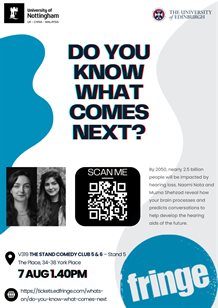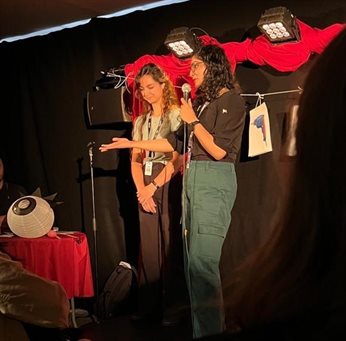The Role of Comedy in Public Engagement: Lessons from Performing at the Cabaret of Dangerous Ideas
‘Do You Know What Comes Next?’
by Muzna Shehzad
The Cabaret of Dangerous Ideas (CoDi) combines academia, the general public, and stand-up comedy to promote outreach and engagement in research. Since 2013, CoDi has been part of the Edinburgh Fringe Festival. During the event, academics are given approximately 20 minutes to present their research in an accessible way, accompanied by a talented stand-up comedian who adds a touch of humour. Following these presentations, there is a 40-minute session of audience interaction, including questions and discussion.
This year, we decided to take our project, running in collaboration with the University of Edinburgh, to the CoDi show at the Edinburgh Fringe Festival 2024. Our research focuses on the prediction of speech, i.e., how we anticipate what somebody will say next, hence the show’s title: ‘Do you know what comes next?’. Our work specifically looks at different stages of prediction: the fast and automatic early stage and the slower and more cognitively demanding later stage. We explore these issues in difficult listening conditions, ranging from increased background noise to hearing loss, both of which we included in our CoDi performance. We use eye-tracking in our research studies, specifically the Visual World Paradigm, which is why an eye costume was a special part of our CoDi performance.

The poster advertising the event (click the image to view a larger version in a new browser tab)
Only a few months after applying to perform at the Fringe, Naomi and I are standing in a stand-up comedy club with an eye costume made from a lamp and numerous earplugs, with a range of new eye-deas of how to bring our research to life. (Forgive the pun, it was ear-resistible!) While this might not be where you might expect academics to end up, it was an exciting adventure we were keen to undertake!
Being one of the performances at CoDi left us with amazing memories and taught us valuable lessons. Following, are some of the key takeaways from our first attempt at using stand-up comedy as a tool for public engagement.
1. Complex ideas made simple:
Simplifying complex scientific ideas while maintaining their true meaning is a tough job. We took serious, complex, and literature-supported facts from our visual world paradigm experiments and turned them into relatable, simple concepts sprinkled with humour. This helped our audience see how our research connects to their daily lives in an engaging and fun manner.
2. Engaging and capturing attention:
Talking about an engaging manner, humour is a powerful tool! We tailored our jokes to be relatable for our Scottish audience (yes, we mentioned kilts), and it was a fun and rewarding task. It made our work more entertaining and memorable, giving the audience something to connect with on a personal level while having a nice laugh.

3. Empathy through shared experience:
One of our main goals was to engage the audience in our performance. We were fortunate to have an audience that was willing to share their personal experiences of living with hearing impairment, including the trials and the tribulations. This had a much stronger impact than a dry description of our research and allowed us to set our work in a real-world context. For those who couldn’t attend, here’s a brief excerpt from what one of our audience members shared:
“…the day that I had my hearing aids fit in, I walked down the street. It was raining, and the raindrops were pattering against the ground. I hadn’t heard it for years and I had tears in my eyes just from the sound. The rain stopped, and the birds started singing – little things like that...”
4. Breaking down barriers:
Public engagement aims to build a bridge between academia and the public. Stand-up comedy helped break down the formality of academia and focus on the key reasons behind our research.
By continuing to break down these barriers, we can encourage a wider range of people to engage with research and recognize their vital role in advancing it. This approach can also invite diverse perspectives and support in making research accessible to populations not yet widely represented in research.
In conclusion, The Cabaret of Dangerous Ideas offered a valuable opportunity for everyone involved. It created an environment where the audience could learn about cutting-edge research, while the researchers could learn from the audience's experience. This provided a platform for everyone to voice their ideas and reduce intimidation through humour. We all left the venue feeling connected and having broadened our perspectives. It might be fair to say that our experience of performing at the CoDi show was simply eye-deal!

An eye costume made from a lamp

The certificate for most eye-catching costume (click the image to view a larger version in a new browser tab)
P.S.: we won the ‘most eye-catching costume’ award. We can safely assume that the pun was, indeed, intended.